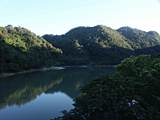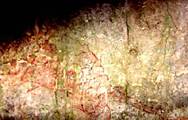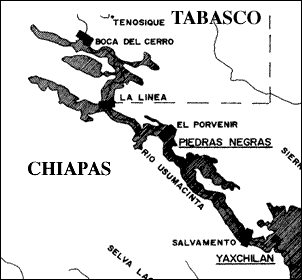
Original report with background info and illustrations
Panhale Menaced by Imminent Destruction
| March 13, 2003. In the next two weeks, preliminary work begins on the damming of the Usumacinta, asccording to the president of Mexico himself. As reported by the newspaper Tabasco Hoy, "In the second half of March, the Federal Electricity Commission begins construction of five hydroelectric facilities on the last free-flowing river in Mexico; work comprised in the 'third stage' consisting in the contruction of roads and accessways together with studies, test pilings, soil engineering and concrete, with funding in the millions of dollars from the Interamerican Development Bank in support of the Plan Puebla Panama. ... Despite the protests of environmentalists and some sixty intellectuals, President Vicente Fox...confirmed the construction." |
|
(The protests referred to in the newspaper article can be tracked on the RíosMayas website.)
Any dam located at the Boca del Cerro will inundate the important archaeological site of Chinikiha and others in its vicinity, and even the preliminary work referred to by President Fox constitutes an immediate threat to the citadel of Panhale, which is located directly above the dam site. |

|
|
According to archaeologist Armando Anaya Hernández, "Of course Panhale itself would be affected. It has already been miserably trenched through by CFE's heavy machinery, and this was just to set a datum at the top of one of its terraces. At the very least CFE would need to construct a road and their monitoring stations on the only suitable terrain available, and these are Panhale's terraces. I would not be the least surprised if they quarry the site for construction materials. This would also give the lime-producing plant the long awaited justification to continue mining the site."
In Archaeology Magazine's online report on the dam threat, Anaya details the damage already caused to Panhale by the Federal Electricity Commission (CFE). He also refers to the nearby sites of San Carlos Boca del Cerro, Chan Marín/Súchite and Rancho La Herradura, which would be partly or completely submerged by even a low dam at the Boca del Cerro. Anaya Hernández's survey work at Panhale and the other sites in the region is documented in his report on the FAMSI website, The Pomoná Kingdom and its Hinterland. In response to claims that the CFE only intends to build a "low" dam of 30 meters in height, Anaya Hernández has modeled a computer map showing that numerous archaeological sites would be inundated. One of these sites, Chinikiha, is a source of Classic-period sculpture and hieroglyphs. (See the rubbings on the other page of Mesoweb's report on the dam threat.) Panhale itself is a Maya site of great significance and longevity. According to Anaya Hernández, some of its architecture dates to the Preclassic, while the site also boasts an impressive Cycle 10 monument (David Stuart, personal communication, 2003). Dating to 10.0.0.0.0 in the Long Count, or AD 830, this monument was one of the last created by the Classic Maya. |
Threatened Murals at Chinikiha
| November 12, 2002. Recently Alfonso Morales and Julia Miller took these photographs of wall paintings at Chinikiha, one of the sites that would be completely inundated by any dam: |

| 
| 
|
Blockades Attract International Attention
|
October 13. This weekend's blockades have already made it into the international press. In a story picked up by the San Francisco Chronicle, the Associated Press reported that thousands of Indians blocked highways in Guatemala and Mexico yesterday, protesting Columbus Day and celebrating their Indian heritage.
Four highways in the Peten region of Guatemala were blockaded by Indian farmers to protest the Usumacinta dam. The news service article specifically mentions the threat of flooding Maya archaeological sites. In Mexico, Zapatista rebels closed a road leading to a military base, demanding that the government cancel the development scheme known as the Plan Puebla-Panama, one component of which involves the hydroelectric projects menacing the Usumacinta. Protest Blockade Planned October 3, 2002: Indigenous people and campesinos from 150 communities in the Lacandon region plan to blockade the road to the Lagos de Montebello at the intersection with the Panamerican Highway south of Comitan starting at 8:00 A.M. on October 12. Representatives from the municipalities of Las Margaritas, Trinitaria, Independencia, Maravilla Tenejapa, Marque de Comilla, Benemerito de las Americas, Tila, Tayalon, Ocosingo y Pulpitillo are protesting the Usumacinta dam with a 24-hour demonstration. The blockade location is at the opposite end of the Lacandon from the dam, but it will impact tourist trade in the lakes, and alert anyone from the communities entering there that a dam is being planned. The protestors are asking for the support of the general public. Their formal announcement reads in part: "NO to the Plan Puebla Panama. NO to the construction of dams. NO to a government that does not take account of the decisions of indigenous communities. And NO to the government of Vicente Fox." |
"Mexico Weighs Electricity Against History"
|
September 22, 2002: Under this headline, Tim Weiner of the New York Times reported on the dam story today. The article stated that a 132-foot-high dam at the Boca del Cerro would generate about two percent of Mexico's energy needs in the next decade at the cost of destroying eighteen known Maya sites, including some with significant structures.
"We know from explorers and looters that there is amazing stuff there waiting to be found," David Stuart was quoted as saying. "If it's under water it's gone — beautiful art, ruins of palaces, hieroglyph inscriptions, stuff we would have nowhere else." Weiner reported that government officials are also considering a 330-foot-high dam that might even threaten the major site of Piedras Negras in Guatemala. "This is a disaster," said archaeologist Stephen Houston, who has worked for years at Piedras Negras. "If Piedras Negras is flooded, it would be the worst disaster ever to be visited on a classic Mayan site." The dam would also inflame the Zapatista rebels and other indigenous groups, according to the New York Times. Alberto López Wario, director of archeological preservation at the National Institute of Anthropology and History, told the reporter that the only plans he had seen called for a dam 330 feet high. |
Chiapas Governer Says No More Dams
|
September 4, 2002: A bitter dispute between the state government of Chiapas and Mexico's Federal Electricity Commission may turn out to be a significant development in the fight against damming the Usumacinta River.
In a press release dated September 3, 2002, the governor of Chiapas, Pablo Salazar Mendiguchía, has announced that his government will not permit the construction of any more hydroelectric dams until such time as the Electricity Commission satisfactorily resolves its outstanding issues with the people of Chiapas. The intractibility of the dispute over electrity rates and the consequences of previous dam contruction in the state is such that it may effectively forestall, for the time being at least, the proposal to dam the Usumacinta and inundate numerous archaeological sites as well as endangered plants and wildlife. The press release was forwarded to the Daily Glyph by Janet Schwartz, who is based in San Cristobal and writes for a number of Chiapas and Tabasco newspapers. Schwartz cautions that the dam proposed for the Boca del Cerro would be located in the state of Tabasco. But the area of inundation would impact Chiapas and therefore presumably require the permission of its government, which would not be forthcoming according to the statement of Governor Salazar. Salazar is said to have told Mexican President Vicente Fox himself that dams previously built in Chiapas have flooded thousands of acres of the best land and caused the loss of signficant production. According to Salazar, the the process of indemnifaction for affected landowners and farmers has been tortuous while the agreements signed to date have not been lived up to. "The position of the State Government is clear," the Governor is quoted as saying. "We are not going to permit a single dam more until the resolution of the outstanding issues with the Federal Electricity Commission." |
home
